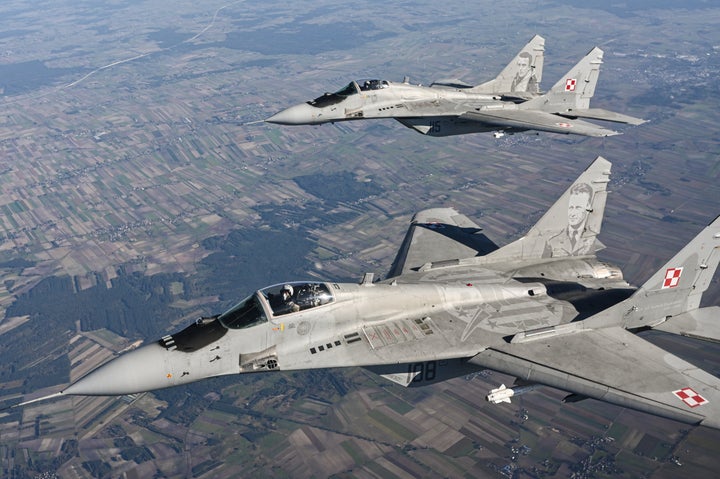
Last month, Ukraine got a huge boost from it Western allies – both in terms of the military hardware it had been bequeathed, and how they were willing to break what had previously been taboo.
After weeks of hesitation, Germany said it would provide Ukraine with 14 Leopard 2 tanks and allow other allies willing to follow suit to deliver 88 Leopards to form two tank battalions. The US, in turn, announced it will send 31 M1 Abrams tanks.
Ukrainian president Volodymyr Zelenskyy greeted the Western decision as a major breakthrough, and Kyiv almost immediately began lobbying for fighter jets from its allies – not least because its current fleet of warplanes are older than modern Ukraine itself. Specifically, Ukraine is pushing for Western fourth generation fighter jets such as the US F-16. Today, President Zelensky addressed the UK parliament at Westminster Hall and again, appealed for fighter jets from the government.
Why does Ukraine need fighter jets?
Ukraine’s Air Force has a fleet of ageing Soviet-era fighter jets They came off the assembly line before Kyiv even declared independence more than 31 years ago. The warplanes are used for intercept missions and to attack Russian positions.
The push for jets reflects how last week’s decision on tanks was a major turning point in military support for Kyiv, which has evolved during the war. Despite being vigilant of the conflict widening, the West are now providing arms that have a mainly offensive rather than defensive purpose, a seismic shift.
Justin Bronk, a researcher at the RUSI think tank in London, tweeted that Ukraine would “absolutely benefit” from Western fighter jets “in terms of air-to-air and (potentially) air-to-ground lethality.”
But he said they would still be at high risk from Russian surface to air missiles, forcing them to fly very low near the front line, something that “would dramatically reduce effective missile range and limit strike options”.
Jets coveted by Ukraine include F-16s and F-35s from the US, Eurofighters, Tornados, French Rafales, and Swedish Gripen jets. As the year unfolds, Ukraine could also receive modern aircrafts as Finland, Germany, and the Netherlands upgrade to US F-35 fighters.
Ukraine has said it would take its pilots about half a year to train for combat in Western fighter jets, meaning if a deal could be done it would not be an instant game-changer.
Is it happening?
Soon after the tanks were confirmed, Andriy Yermak, Zelenskyy’s most senior adviser, suggested Poland is willing to supply Ukraine with its F-16 fighters, and follows speculation over a “fighter jet coalition” to match Russia’s supply.
Yermak said in a Telegram posting Ukraine had received “positive signals” from Warsaw. However, Poland’s prime minister, Mateusz Morawiecki, was careful to stress his own country would only act in consultation with Nato allies.
Why does Nato matter?
The military alliance called the North Atlantic Treaty Organisation – or Nato – and its 30 member nations are bound by Article 5 of its constitution. They agree to mutual defence – military action – in response to an enemy attack. The principle goes: “An attack against one ally is considered as an attack against all allies.”
Ukraine is not a member of Nato. But if any of the Nato countries became directly involved, it would be interpreted as an act of war by Putin, dragging countries including the US and UK further into the conflict.
Nato is anxious about further escalating tensions between the world’s two biggest nuclear powers – the US and Russia – and edging everyone closer to the “World War III” scenario many fear.
Haven’t we been here before?
Ukraine’s Air Force has yearned for better aircraft throughout the war, but it was the fear of escalation that halted previous efforts to supply Ukraine with jets.
In March, just weeks after the invasion, Poland said it would give all of its MiG-29 fighter jets to the US – a move that potentially allowed the warplanes to be passed along for use by Ukraine’s military. But the US rejected the offer, which would be in exchange for US jets, characterising the plan as “not tenable”.

Among a series of logistical problems, one question was how to deliver the planes to Ukraine since Poland is a member of Nato, and Nato pilots couldn’t fly the aircraft to Ukraine without risking the alliance’s involvement.
But as shipping tanks to Ukraine demonstrates, and as the war enters its second year, there are fewer fears over the domino effect.
The Kremlin has warned that tank deliveries would be a dangerous escalation of the conflict in Ukraine, and it has strongly denounced the watershed move by Germany and the US to send the heavy weaponry to its foe. But it has also insisted the new armour won’t stop Russia from achieving its goals in Ukraine, and that the Ukrainian armed forces “is clearly exaggerated”.
What are the sticking points?
But are we about to see the same back-and-forth over tanks. As UK defence secretary, Ben Wallace, on Monday noted: “I think what we know about all these demands is that…the initial response is no and it ends up being yes.”
Echoing its early reluctance to send tanks, Germany has ruled out the idea of sending jets to Ukraine. Berlin’s reticence ultimately stems from a post-Second World War aversion to military aggression.
Speaking in an interview with German newspaper Tagesspiegel published on Sunday, chancellor Olaf Scholz said: “The question of combat aircraft does not arise at all. I can only advise against entering into a constant competition to outbid each other when it comes to weapons systems.”
The caution is despite being the third-largest weapons supplier to Kyiv, and being a member of Nato.
